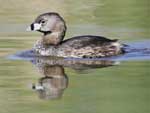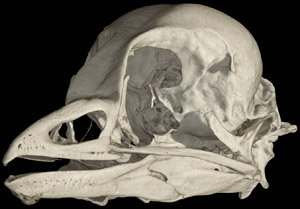The pied-billed grebe (Podilymbus podiceps) is a common diving bird found throughout North America. Grebes are widely-distributed, fairly small, and excellent swimmers. However, their adaptations  for foot-propelled diving -- including webbed, lobed toes, and feet placed far back on their bodies -- make them very ungainly on land. As a result, grebes spend most of their time in the water and leave only to nest. This group of birds is probably related to other major groups of seabirds such as penguins, loons, and tubenoses (Sibley and Ahlquist, 1990; Mayr and Clarke, 2003). It has also been suggested that grebes are most closely related to flamingos and not at all to other seabirds, although some morphological evidence does not agree with this hypothesis (van Tuinen et al., 2001; Mayr, 2004; Storer, 2006). The disagreement results from different morphological and molecular data, which is probably related to anatomical convergence among seabirds adapted to similar environments. for foot-propelled diving -- including webbed, lobed toes, and feet placed far back on their bodies -- make them very ungainly on land. As a result, grebes spend most of their time in the water and leave only to nest. This group of birds is probably related to other major groups of seabirds such as penguins, loons, and tubenoses (Sibley and Ahlquist, 1990; Mayr and Clarke, 2003). It has also been suggested that grebes are most closely related to flamingos and not at all to other seabirds, although some morphological evidence does not agree with this hypothesis (van Tuinen et al., 2001; Mayr, 2004; Storer, 2006). The disagreement results from different morphological and molecular data, which is probably related to anatomical convergence among seabirds adapted to similar environments.
Six genera and 20 species make up the grebes, or Podicipedidae, including Aechmophorus, Podiceps, Podilymbus, Poliocephalus, Rollandia, and Tachybaptus. Relationships among these species were only recently analyzed by cladistic methods (Fjeldså, 2004), where it was suggested that the pied-billed grebe and the least grebes (Tachybaptus) are most closely related to each other, to the exclusion of all other grebes. Pied-billed grebes are the only living species of Podilymbus, since their closest relative, the Atitlan grebe (P. gigas) of Guatemala, went extinct in 1989.
The pied-billed is the most widespread of North American grebes, ranging from Alaska and northern Canada to temperate South America and the Caribbean. It rarely flies and spends most of its time in ponds, lakes, and marshes eating fish, insects, and amphibians. Pied-billed grebes can be recognized by their small size, brown or gray color, conspicuous white ring around the eye, and short bill encircled by a broad black band, which gives them their common name (Muller and Storer, 1999). The pied-billed grebe is seasonally monogamous, as are all grebes, but does not engage in the intricate courtship displays typical of other grebes. The conservation status of pied-billed grebes is currently good, although declines have been noted in some of their range owing to habitat destruction (American Ornithologists’ Union, 1998).
Additional Information on the Skull
Click on the thumbnails below for labeled images of the skull in standard anatomical views.

About the Species
This specimen, an adult, was collected from Rockport, Aransas County, Texas by J. Corbin in December 1969. It was made available to The University of Texas High-Resolution X-ray CT Facility for scanning courtesy of Dr. Nina Triche of The University of Texas at Austin Department of Geological Sciences. Funding for scanning was provided by Dr. Timothy Rowe of The University of Texas at Austin. Funding for image processing was provided by a National Science Foundation Digital Libraries Initiative grant to Dr. Rowe.

About this Specimen
The specimen was scanned by Matthew Colbert on 3 November 2006 for a total of 1110 1024x1024 pixel slices. Each slice is 0.05573 mm thick, with an interslice spacing of 0.05573 mm and a field of reconstruction of 26.4 mm.

About the
Scan
Literature
American Ornithologists' Union. 1998. Check-list of North American birds. American Ornithologists' Union.
Fjeldså, J. 2004. The Grebes: Podicipedidae. Oxford University Press, New York, NY.
246 pp.
Mayr, G. 2004. Morphological evidence for sister group relationship between flamingos
(Aves: Phoenicopteridae) and grebes (Podicipedidae). Zoological Journal of the Linnean Society 140:157–169.
Mayr, G., and J. Clarke. 2003. The deep divergences of neornithine birds: a phylogenetic analysis of morphological characters. Cladistics 19:527-553.
Muller, M., and R. Storer. 1999. Pied-billed Grebe (Podilymbus podiceps). In: A. Poole, and F. Gill (eds.), The Birds of North America, Vol. 410. The Birds of North America Inc, Philadelphia.
Sibley, C. G., and J. E. Ahlquist. 1990. Phylogeny and classification of birds: a study in molecular evolution. Yale University Press, New Haven.
Storer, R. 2006. The grebe-flamingo connection: a rebuttal. The Auk 123:1183-1184.
van Tuinen, M., D. B. Butvill, J. A. W. Kirsch, and S. B. Hedges. 2001. Convergence and
divergence in the evolution of aquatic birds. Proceedings of the Royal Society of London B 268:1345-1350.
Links
Podilymbus podiceps page on birdweb.org
P. podiceps page on Wikipedia
Images of P. podiceps at birdphotography.com
P. podiceps page on the Animal Diversity Web (University of Michigan Museum of Zoology)

Literature
& Links
Front page image.
|  |

Additional
Imagery
|

